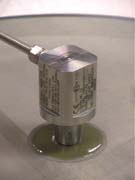Ultrasonic Deblinding System Improves Powder Coating Sieving
Most sieves used throughout the world are of the vibratory type, and with the advent of larger-capacity mills there has been a need for greater-capacity screens to be placed beneath them.
A 'straight-through' design sieve with one motor mounted at the side can give the capacity and accuracy to match these large mills. They can achieve rapid sieving through fine meshes due to their gyratory motion. Instead of simple reciprocating movements, the sieve's vibrator causes the mesh to move rapidly in a small-diameter, circular orbit, but without itself rotating. Two adjustable weights in the vibrator unit regulate the horizontal and vertical amplitudes.
By locating this type of sieve under the rotary or twin valve at the base of the cyclone classifier, the finished powder can be weighed off and packaged in a convenient, controlled manner. Most fine powders being currently produced have an average particle size of 30 microns; therefore security sieving through a mesh with an aperture size between 100 microns and 160 microns to remove contaminant will give a good-quality product. Throughput depends on specific gravity and pigment loading but is typically 600-1800 kg/h. This means that a single sieve can match the production rate of a large grinding mill.
The unique movement gives rapid sieving results because the powder particles are rolled in two directions across the mesh and thus present themselves to the apertures in a large number of different orientations in quick succession.
Low-height, straight-through screeners are easy to strip down and clean when changing colors, as all the contact parts can be removed without the need for tools. All parts that contact the product are stainless steel. Rubber suspension mounts make the unit far quieter in operation compared with springs and noise levels are typically as low as 70 dB(A).

Ultrasonic Developments
In the past, the biggest single problem of sieving electrostatic powder coatings has been mesh blinding. Some powders are more prone to this phenomenon than others, but all are affected to a degree due to the static nature of the product itself.Over the years, many deblinding devices have been used - bouncing rubber balls, scraper rings and brushes - to delay and reduce the effect of blinding. These methods cause potential product contamination and reduced mesh life. Therefore, most manufacturers have resorted to using larger mesh sizes than they would ideally wish to use because of the blinding effects.
Specialist applications, such as those carried out by automotive manufacturers, have encountered the problem of sieving powders on finer meshes to produce "thin-film coating" for primary and secondary coatings on car bodies. The desire to sieve as low as 63 microns has been impossible to achieve without the use of ultrasonic to deblind the mesh.
However, an ultrasonic deblinding system has been able to eliminate this problem. The system ultrasonically excites the stainless-steel mesh wires with a low-amplitude, high-frequency vibration. This effectively makes the wires friction free and prevents particles blocking or grounded the mesh. The ultrasonic probe is continually grounded, which eliminates any possibility of static build up on the mesh and therefore prevents build up of the powder that is being sieved.
The ultrasonic deblinding system works on the power by demand (PBD) principle, which solves the problem of uneven loading - constant feedback, from the separator screen to the PBD controls, monitors the throughput of material in the system. When there is a heavy loading on the separator screen, PBD increases power, maintaining the amplitude of the ultrasonic activity to pass materials through quickly and efficiently without blinding.
With blinding eliminated, higher capacities can be enjoyed, sieving on finer meshes made possible and mesh life increased due to reduced manual cleaning and the elimination of mechanical deblinding systems.
Using the combination of a single sieve and an ultrasonic deblinding system, the sieving of most electrostatic powder coatings at the speed of larger mills, or on meshes as fine as 63 microns with capacities up to 1600kg/h, is possible.
Powder Recovery
At users' premises, combined screening of virgin and overspray powders has now become standard good manufacturing practice. If the reclaimed overspray powder - which must be sieved because of the near-certainty of contamination - is recycled separately from the virgin powder, the quality of coating on the finished products is likely to vary. It therefore makes sense to draw virgin and overspray powders to one point where they can be sieved together in known proportions into the fluidized-feed hopper for the powder guns.The sieve and ultrasonic deblinding system combination is ideal for this reclamation of paint as well as breaking down any agglomerates in the virgin powder caused by compression during transit. Using a 125-micron mesh, a clean, homogeneous and aerated feed to the powder guns is guaranteed.
The sieving process may be manual or fully automatic. In the automatic system, sensors signal when the powder level is low in the feed hopper. A vacuum transfer system then draws recovered powder from beneath the cyclone dust collector and simultaneously pulls virgin powder into a collection hopper alongside the sieve. Where bulk powder containers are used, these can be sited over 30m from the feed hopper. In the manual system the sieve is fed by scoop. This will usually be carried out off line.

ATEX Directive Impact
On March 1, 1996, the European community adopted a directive on equipment and protective systems intended for use in potentially explosive atmospheres (94/9/EC), 'Atmospheres Explosibles' more commonly referred to as the ATEX Directive. The ATEX Directive's primary function is to eliminate the possibility of explosions. It applies to electrical and mechanical equipment intended for use in potentially explosive atmospheres.Historically, powder paint has not been classified as potentially explosive, however the introduction of the ATEX Directive is redefining the standards of classification of all coatings. This means that electrical equipment operating in a powder paint-manufacturing environment will need to meet the directive.
The introduction of the directive is having a huge impact throughout the powder paint industry. Companies working with electrostatic powder paint were one of the first to react to the directive, and many have already installed ultrasonic deblinding systems certified for use in Zone 20 areas.
When an electrical component is continuously in contact with powder and dust during sieving there is a potential hazard of an explosion. The new Zone 20 transducer and cable are totally enclosed, eliminating the possibility of any explosion and to avoid the possibility of ignition of a hazardous atmosphere. This system gives the user complete peace of mind and meets essential health and safety requirements.
The directive affects all industries involving powders, dusts and vapors, including powder paint, metal powders, food, pharmaceutical powders and chemicals. The Russell Vibrasonic probe is certified for group II, category 1, gases and dusts and explosion protection is to E Ex d m IIC T4. The Russell Vibrasonic Deblinding System has attained certification for use in Zone 20 areas in accordance with the directive.
By July 2003, all new equipment purchased for installation and use in a potentially explosive atmosphere must comply with the requirements of the ATEX Directive.
For more information about ultrasonic deblinding technology, contact Russell Finex, Inc., 625 Eagleton Downs Dr., Pineville, NC 28134; phone 704-588-9808; or visit www.russellfinex.com.
Ultrasonic Deblinding Technology Part of USCAR Research
Ultrasonic deblinding technology allows powder paint manufacturers to screen powder down to 50 microns, which is impossible with conventional sieves. It also allows much higher capacities than previously possible. The United States Council for Automotive Research (USCAR), made up of leading U.S. car manufacturers Ford, Chrysler and General Motors, is using two ultrasonic mesh deblinding systems in a joint research program looking into ways of reducing solvent emissions from automotive painting systems.Based at a $20-million, 107,000-sq-ft Ford Assembly Plant in Wixom, MI, the USCAR study also aims to accelerate the introduction of solvent-free technology, and in particular focuses on determining whether powder clearcoat is smooth and durable enough to be used as a clear vehicle topcoat.
Car manufacturers have used powder as anti-chip and primer surfaces on many components for some years to increase durability, and in the last three years, over 10 car manufacturers have purchased ultrasonic vibratory sieving machines. However, frequent color changes have made powder unsuitable for use as a color coat and also limited reclaim capabilities.
The USCAR project involved the application of a powder clearcoat to car parts under strictly controlled conditions before the bodies are subjected to rigorous tests, the validity of which relies entirely on the quality of the powder.
To ensure the high quality standards and throughput required, two high-performance sieves fitted with ultrasonic mesh deblinding systems have been installed above powder hoppers in the powder kitchen which pump both virgin and reclaim powders. After sieving, the powder is pneumatically conveyed to a 10-meter down draft spray where spraying equipment automatically applies the powder clearcoat to the car bodies before testing.
Previously, it had been difficult to screen fine powders efficiently using rotary sieves over long periods of time due to progressive mesh blinding. However, now using the ultrasonic deblinding system, this problem has been eliminated, even on mesh sizes down to 75 microns, giving far improved plant efficiency and continuous operation over many shifts.
As well as reducing downtime, the ultrasonic system extends screen life from weeks to months while giving exceptional precision and dramatically increased throughput.
Looking for a reprint of this article?
From high-res PDFs to custom plaques, order your copy today!




